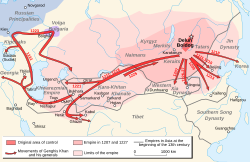Mongol Invasion of Europe
| Mongol invasion of Europe | |||||||||
|---|---|---|---|---|---|---|---|---|---|
| Part of Mongol invasions and conquests | |||||||||
 The route of the first Mongol expedition in Russia – 1223 |
|||||||||
|
|||||||||
| Belligerents | |||||||||
|
Mongol Empire |
a) Vladimir-Suzdal Novgorod Republic Principality of Ryazan Volga Bulgaria Alans Cuman-Kipchak confederation Circassians North Caucasian peoples b) c) Kingdom of Croatia d)Second Bulgarian Empire |
||||||||
| Commanders and leaders | |||||||||
| a) Batu Khan Möngke Khan Subutai Jebe Burundai Berke Orda Güyük Khan b) Baidar (possibly †) Kadan Orda Khan c) Batu Khan Subutai Shiban Berke Burundai d) Batu Khan Kadan |
a) Mstislav Mstislavich Yuri II of Vladimir † Mstislav III of Kiev (POW), executed Dmitro Khan Köten b) Daniel of Galicia Various, most prominent being c) Archbishop Ugrin Csák † Archbishop Matthias Rátót † Palatine Denis Tomaj † d) Ivan Asen II |
||||||||
| Strength | |||||||||
| a) 20,000 in 1223 In 1236, More than 35,000 Mongols+More than 40,000 Turkic auxiliaries b) about 10,000 (one tumen) c) Former estimation: 70,000 New estimation: 30,000 |
a) 80,000 in 1223
b) over 10,000-30,000+at least 500 armed men from Templar order. c) Former estimation: 80,000 New estimation: 25,000 including Hungarian heavy cavalry, Knights Templar, nomadic light cavalry mercenaries and Serbian valiants. Thousands of Cumans and Kipchaks |
||||||||
| Casualties and losses | |||||||||
| a) More than 7,000
b) Minimal c) Few thousands killed |
a) 500,000 (6-7% of the population of Rus) b) Heavy c) 15-25% of the population killed |
||||||||
The Mongol invasion of Europe in the 13th century was the military effort by an Asian power, the Mongol Empire, to invade and conquer parts of Europe. It involved the severe and rampant destruction of East Slavic principalities and major cities, such as Kiev and Vladimir. Mongol invasions also affected Central Europe, leading to conflict with the Kingdom of Hungary (in the Battle of Mohi, 11 April 1241) and causing the fragmentation of Poland (in the Battle of Legnica, 9 April 1241).
The operations were masterminded by General Subutai (1175-1248) and commanded by Batu Khan (c. 1207–1255) and Kadan (died c. 1261), both grandsons of Genghis Khan. As a result of the invasions, many of the conquered territories would become part of the Golden Horde empire.
Historians regard the Mongol raids and invasions (of which the invasions in Europe formed a minor part) as among the deadliest conflicts in human history up through that period.
Warring European princes realized they had to cooperate in the face of a Mongol invasion, so local wars and conflicts were suspended in parts of central Europe, only to be resumed after the Mongols had withdrawn.
Ögedei Khan ordered Batu Khan to conquer Rus' in 1235. The main force, headed by Jochi's sons, and their cousins, Möngke Khan and Güyük Khan, arrived at Ryazan in December 1237. Ryazan refused to surrender, and the Mongols sacked it and then stormed Suzdalia. Many Rus' armies were defeated; Grand Prince Yuri was killed on the Sit River (March 4, 1238). Major cities such as Vladimir, Torzhok, and Kozelsk were captured.
...
Wikipedia
